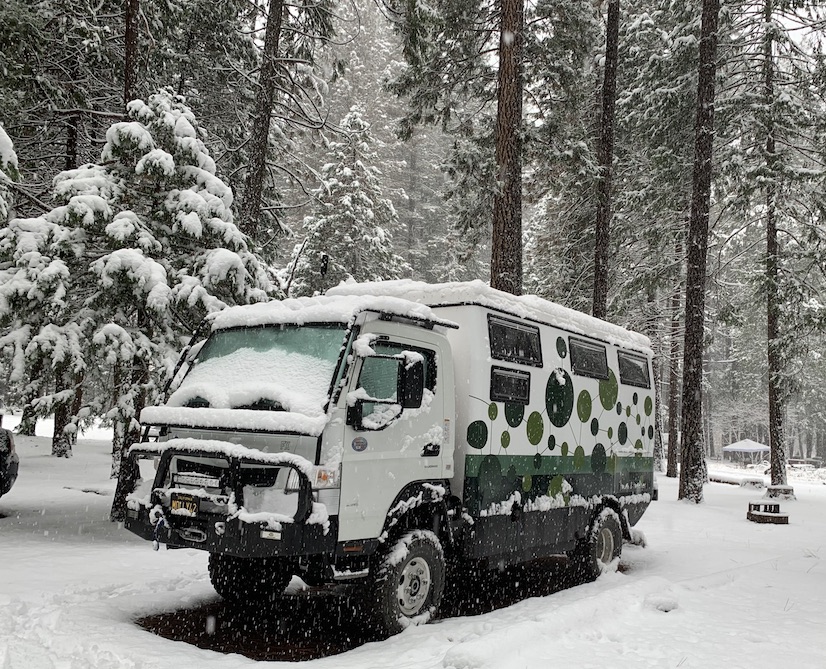
Cold weather can damage Molly. Freezing of the water systems is the number one danger that will cause damage. So in cold weather we have a protocol to prevent freezing damage. With every cold weather trip we learn and make adjustments if needed.
1 . We drain the secondary water tank. This tank is located on the outside of the truck and will quickly freeze. Draining the tank is easy, by removing the drain plug. Alternatively we can pump the water into the primary tank. If we want the extra water, for whatever reason, instead of draining the water tank, we turn on the water tank heater.
2. The gray water tank is also outside of the house, so ideally we don’t want water in this tank either. Typically we will open the outlet valves and drain to either a bucket or in an environmentally appropriate way. If this is not possible we turn on the gray water tank heater. Using the gray water heater is not a great option, as the outlet gate valve has to be closed to allow the discharge pipework to be drained. This outside section has to be drained to prevent it getting frozen solid. But then the outlet gate valve will freeze in the closed position. Once that happens, warm weather is required to unfreeze it and open it back up.
3. The primary water tank has a gravity fed gravity outlet. This outlet is drained by closing the valve in the house while opening the outside valve and draining the section of pipe that is located outside the house. Should the house heating and electrical pump fail, then in an emergency we can use this valve and disconnect the pump to drain the house of all water.
4. Turn on the toilet circulation fan. This fan moves heat in the house to the rear storage area where the primary water tank, water management station and outside shower piping are located; and prevents these from freezing. We have a bluetooth temperature sensor in this area to keep an eye on things in the rear storage area.
5. Turn on the internal air and water space heater (winter mode). We always turn on the water heater to prevent the Webasto from automatically dumping the water from the boiler; which it will do when the temperature is below 6°C (it is a frost protection feature of the Webasto dual top heater). Having hot water in the boiler also happens to be a good idea.
6. Maintain good charge levels of the house batteries and fuel levels of the truck diesel tank. These are the two energy sources needed to generate heat from the Webasto dual top air heater.
7. In very cold weather we lower the barrier between the house and the front cab. This barrier keeps more heat in the house and reduces the amount of condensation in the front cab. We also (well actually always) put up the privacy shields in the front cab.
The above seven-step protocol is completely manual and therefore error prone. In case we forget something, Molly has a low temperature alarm. If the outside temperature falls below 4°C for 30 minutes, any of the following conditions will cause the alarm to sound. It is loud enough to wake us up, and it has in the past.
- Secondary Water tank level is above 10% full and it’s heater is off (circuit breaker is open).
- Gray water tank level is above 10% full and its heater is off (circuit breaker is open).
- House battery State of Charge is below 25%.
The outside temperature is calculated as the lowest reported value of any of the outside temperature sensors; there are a total of 6 of them. There is the temperature sensor which is part of the weather monitoring system and 5 sensors, one on each of the tires as part of the TPMS system (4 regular tires and 1 spare).
Should the house heating system fail, we have two other options to heat ourselves. We can start the diesel stove-top. Should this fail as well, then as a final option, we can keep ourselves warm using the truck heating system, but this requires us to idle the truck engine. At idle Molly probably uses 0.5 US gal/hour. So half a tank would last around 60 hours. Should be enough if everything else goes wrong.
As a side note, the Fuso Owners manual states that “THE VEHICLE’S OPERATING ENVIRONMENT TEMPERATURE IS -25°C TO +40°C (-13°F TO +104°F).”

